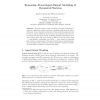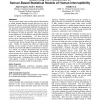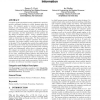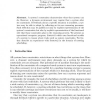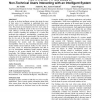279 search results - page 4 / 56 » Learning and reasoning about interruption |
IDA
1999
Springer
13 years 11 months ago
1999
Springer
The goal of input-output modeling is to apply a test input to a system, analyze the results, and learn something useful from the causeeffect pair. Any automated modeling tool that...
CHI
2004
ACM
14 years 7 months ago
2004
ACM
Current systems often create socially awkward interruptions or unduly demand attention because they have no way of knowing if a person is busy and should not be interrupted. Previ...
ATAL
2008
Springer
13 years 9 months ago
2008
Springer
Computer agents participate in many collaborative and competitive multiagent domains in which humans make decisions. For computer agents to interact successfully with people in su...
AI
2001
Springer
13 years 11 months ago
2001
Springer
A system's constraints characterizes what that system can do. However, a dynamic environment may require that a system alter its constraints. If feedback about a specific situ...
CHI
2007
ACM
14 years 7 months ago
2007
ACM
In order to develop intelligent systems that attain the trust of their users, it is important to understand how users perceive such systems and develop those perceptions over time...
